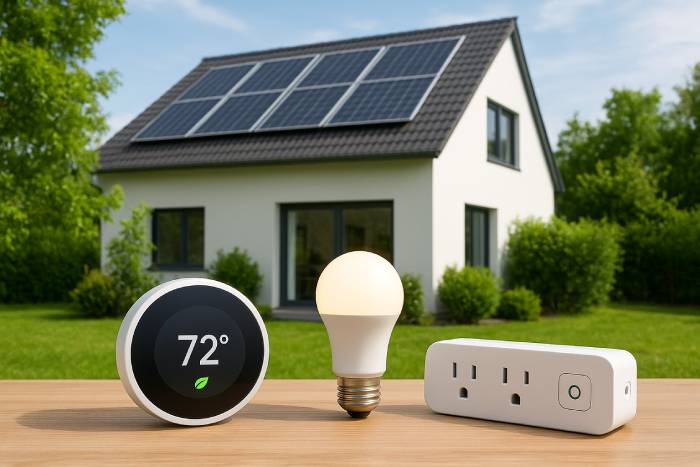In a time of technological advances our homes are becoming more sophisticated. The development of smart homes that is powered through AI (AI) provides unimaginable comfort in controlling our living spaces. While we are embracing these new technologies, it’s important to think about their impact on the environment. This blog post dives into the world of environmentally friendly AI devices and explains the ways in which their use in smart homes can open the way to an environmentally sustainable future.

Introduction
The idea of having an intelligent home that was once only a realm of sci-fi, has become becoming a real. AI devices used to create smart houses are now regular, providing efficiency and automation for a variety of household tasks. As we implement the latest technology and gadgets into our daily lives the power consumption and environmental impacts of these devices require our attention.
Eco-friendly AI devices are a major change in the field of intelligent home technologies. They’re designed not just to be convenient, but also in a the intention of reducing their impact on the environment. This includes things like efficiency in energy use, the utilization of environmentally friendly materials, and features that help to reduce the use of resources within the home.
Sustainable technology is a must in today’s smart homes for a number of compelling reasons. In the first place, energy usage in homes can significantly contribute to the emission of greenhouse gases. If we adopt energy-efficient devices that reduce the carbon footprint of our home and lessen the impacts on climate change. Additionally, sustainability encourages sustainable resource management and addresses the issue of water pollution and food waste as well as the life cycle for electronic equipment. Furthermore, investing in environmentally friendly technology can result in long-term savings on costs due to reduced consumption of energy and a reduction in waste.
AI plays an essential role in achieving these sustainability targets. The ability of AI to analyze data, recognize patterns, and make smart decisions allows smart devices to improve their operation to minimize environmental impact. From intelligently altering the thermostat to preventing water leaks, AI offers a powerful toolset for creating truly eco-friendly smart homes.

1. The role of AI in the creation of a greener Home
Artificial Intelligence is the powerhouse behind the efficiency of eco-friendly devices. How can AI-powered devices improve the use of energy and resources? They use machine learning algorithms to analyze the user’s behavior, anticipate their requirements, and alter the settings automatically. For example an AI thermostat can learn your preferences in cooling and heating and adjusts temperature automatically according to occupancy and weather forecasts, thus avoiding unnecessary energy consumption. In the same way, AI lighting systems can detect patterns of movement and the ambient light levels, and lower or shut off lights when they’re not required.
The distinction between standard smartphones and environmentally friendly AI gadgets typically lies in their basic design and the technology built into the devices. While a typical smart device could provide the capability of remote control or scheduling however, an environmentally friendly AI gadget takes it a step further, actively improving its performance to ensure sustainability. It makes use of machine learning and analysis of data to make decisions on its own which reduce the amount of energy used and waste produced without needing constant input from the user.
The positive environmental impacts associated with these technology are increasingly evident, as demonstrated by the latest statistics and cases research. For instance, studies have demonstrated that smart thermostats can provide energy savings up 15% on cooling and heating costs. The irrigation system powered by AI has proven significant reductions in the use of water for landscaping. Smart refrigerators equipped with expired tracking and food identification capabilities could contribute to a significant reduction in household food waste that has major economic and environmental impacts.
2. Energy-Efficient AI Gadgets
Energy conservation is an essential component of a smart green home as AI powered devices are at the forefront of this trend:
Smart thermostats The devices recognize your temperature and air conditioning preferences and design a customized schedule. They can recognize when you’re not home and automatically alter the temperature to save energy. Advanced models can even incorporate forecasts for weather to optimize cooling and heating and significantly reduce energy consumption.
AI Lighting Systems: The days are gone of putting lights on incessantly. AI lighting systems rely on sensors (motion or occupancy, sunlight) as well as algorithms that automate adjustments to lighting. They can dim the lights according to the availability of natural light or turn off lighting in rooms not occupied and can even discover the lighting settings you prefer during different time of day, resulting in significant energy savings.
Smart Power Strips The Phantom Load, also known as standby power generated by connected devices that are not being used can significantly increase the energy consumption. Smart power strips with AI capabilities detect devices that aren’t using them and turn off the power source. Certain models with advanced technology can prioritize power to the most important devices during times of peak demand, thereby improving energy efficiency.
3. Gadgets for Water Saving AI
Water scarcity is a rising global issue. AI offers new solutions to conserve water in smart homes.
AI-Enabled irrigation Systems: Traditional sprinkler systems usually waste water due to following rigid schedules regardless of the actual requirements. AI-enabled irrigation systems in contrast employ information on weather sensors for soil moisture and even water requirements specific to plants to improve the timing of watering. They water only where it is required, avoiding the overwatering of runoff and resulting to substantial savings in water.
Smart Shower Systems The systems give users real-time information on the amount of water used and temperature. Certain models are able to determine your preferred duration of shower as well as temperature and inform users when they’ve reached their desired goal, encouraging more mindful use of water. Options like pause buttons as well as flow regulators also contribute to the conservation of water.
sensors for leak detection Leaks in the water that aren’t visible could result in water waste and result in costly damages. Leak detection sensors powered by AI are able to be installed in vulnerable locations like beneath sinks or close to water heaters. They employ sensors as well as AI algorithms to identify unusual water flow or water, and immediately alerts to your mobile to allow for quick intervention, and also preventing significant water loss.
4. Waste-Reduction AI Gadgets
Beyond water and energy, AI is also helping in tackling the problem of household waste
Artificial Intelligence-Integrated Intelligent Fridges: Food waste is a significant economic and environmental problem. Smart refrigerators equipped with AI capabilities are able to track the food items stored within as well as monitor expiry dates and even recommend recipes based upon available ingredients. Some models can even recognize foods using images which helps you track your food inventory and reducing loss.
Intelligent Recycling Bins The correct sorting of waste is essential for efficient recycling. Artificial Intelligence-powered smart recycling bins use sensors and image recognition to identify and sort various types of trash. They also monitor your recycling habits and give feedback that encourages better ways of managing waste. Although it is still in its an early stage this technology could dramatically increase recycling rates and decrease waste from landfills.
Artificially-powered Cooking Assistants Accurate measurement of ingredients is essential to reduce the amount of food wasted during cooking. AI-powered cooking assistants, which are often built into smart devices or displays that can help you navigate recipes using precise measurements. They can even alter quantities based on the amount of food served which can help avoid excessive ingredients or food spoilage.
5. Renewable Energy Integration
For a truly eco-friendly smart home, the integration of renewable energy sources such as solar panels is vital. AI plays an essential role in optimizing the utilization of this renewable energy source:
What AI Gadgets work with Solar Panels: AI energy management systems can track the solar energy produced by solar panels as well as the consumption of energy by your smart home appliances. Through analyzing these data streams AI can use its intelligence to schedule activities that consume energy, like cleaning dishwashers or charging electrical vehicles at peak solar energy production hours, maximising the efficiency of renewable energy sources and reducing dependence on grid.
AI Energy Management Systems: These sophisticated systems are the brains of your home’s energy system. They are able to predict demand for energy using previous data and forecasts of weather optimise the charging and discharge of batteries storage systems (if coupled with solar panels) and can even sell excess solar energy back into the grid at times when it is most advantageous. AI makes sure that energy from renewable sources is utilized effectively and efficiently in your smart home.
6. Cost Savings & Long-Term Benefits
The initial investment in eco-friendly AI devices could seem like a challenge however, they provide substantial savings in cost and provide long-term benefits:
How Eco-friendly AI Gadgets Help Save money over time: The primary way the gadgets help save money is through lower energy bills. Lighting systems and thermostats that use less energy can reduce electricity usage, and intelligent irrigation systems reduce the use of water. In addition, by preventing the waste of food and maximizing the use of renewable energy the devices can provide large savings over time.
Real-life Examples or Case Research: Numerous case studies have shown the ROI the investment (ROI) of green smart home technology. Homeowners who have invested in smart lighting and thermostats often have significant reductions in their energy costs within a shorter time. In the same way, users of AI-powered irrigation systems have experienced significant reductions in their water usage. The cumulative impact from these savings throughout the life of the device could be significant, making them an investment that is financially prudent over the long term.
7. Challenges and Considerations
Despite the numerous benefits there are pitfalls and issues to be aware of when implementing eco-friendly AI devices:
The initial cost and setup Issues: The upfront cost of certain sophisticated eco-friendly AI devices could be more expensive than traditional or standard smart gadgets. In addition, initial installation and integration with smart home systems already in use may require a bit of technical expertise or expert assistance. But, as technology becomes more commonplace, prices will likely to fall and the setup process will be easier for users.
Information Privacy and Security of AI-powered devices: AI devices collect and analyze huge quantities of data on our behavior and preferences. The concerns about privacy and security are legitimate. It’s essential to choose reliable brands that have robust security features and also to know the way your personal data is utilized. It is essential to update your firmware regularly and be aware of privacy settings are vital to minimize the risks.
Selecting Eco-friendly Gadgets that are truly eco-friendly in comparison to. “Greenwashed” Items: As sustainability becomes an increasingly popular marketing term it is essential to choose wisely and stay away from “greenwashed” products which make false claims about the environment. Be sure to look for clear information on the energy efficiency of products, material sources, and the entire life cycle of the product. Reading certifications and reviews by independent experts will help you find the most eco-friendly alternatives.
8. Tips to Select the Best Eco-Friendly AI Gadgets
Making educated choices is the key for building a sustainable smart home.
Energy Star Ratings and Eco-Certifications Find products that have recognised energy efficiency certifications, such as Energy Star. These certifications show that the product has met certain standards for energy efficiency. Other eco-certifications relating to manufacturing and materials are also a good indicator of the product’s environmental responsibilities.
Compatible with existing Home Automation Home Systems: Ensure that the latest eco-friendly AI devices can be integrated into your existing smart home system. Make sure that they are compatible to your chosen smart home system (e.g., Amazon Alexa, Google Home, Apple HomeKit) to make sure smooth integration as well as control.
Important to have Software Updates and long-term manufacturer support: Find manufacturers who offer regular updates to their software on their equipment. They usually contain performance enhancements as well as security patches and even new energy-saving features. Support for long-term manufacturers guarantees that your devices are operational and secure throughout their lifetime, thus reducing the need for replacements that are premature.
9. Future Trends in Eco-Friendly AI to Smart Homes
The area of eco-friendly AI for smart homes is always developing, with new and exciting developments in the near future:
The upcoming AI advancements for sustainability: Future AI advancements are expected to provide more advanced energy management features, more accurate maintenance for appliances that will reduce waste and a an easier integration into renewable grids. We could also witness AI playing a larger role in optimizing the whole life-cycle of smart home appliances including sustainable manufacturing, to sustainable disposal.
Future predictions for HTML0 in the next 5-10 years: In the next 5-10 years, we may see a more widespread acceptance of green AI devices as the cost of these gadgets decreases and the awareness of consumers increases. It is possible that we will encounter more connected systems that can holistically manage the home’s energy and consumption of resources. In addition, advances in sensors and AI algorithms could make for greater efficiency and precision in resource administration for smart homes.
Conclusion
Integrating AI in our smart homes can be a great way to adopt a greener way of life. Green AI-powered gadgets used in smart homes aren’t an abstract concept but rather actually a reality, allowing us to decrease the impact on our environment while experiencing the convenience and ease of living spaces that are intelligent. By choosing to use sustainable technologies will contribute to an energy-efficient future for us and future generations to be.
Call-to-action: Explore the potential of eco-friendly AI devices and start taking the first steps to build an eco-friendly smart home. Consider investing in technologies that will improve your lifestyle but also help create an environment that is healthier. Every move that you take, from putting in an intelligent thermostat or choosing energy efficient lighting, can make a difference to creating a more sustainable and greener future.










